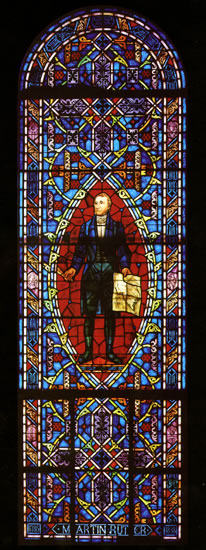
Before his term of service expired, he was appointed president of Augusta College and remained there until 1832. Desiring to devote himself to the ministry, he was transferred to the city of Pittsburgh. In 1833, when Allegheny College was accepted by the conference, Ruter was unanimously selected as president. He accepted the position in 1834 and remained until 1837 when he was appointed superintendent of the mission to Texas with Littleton Fowler and Robert Alexander as assistants.
He rode more than 2,000 miles on horseback, often preaching as many as three times a day. He visited parts of “border Texas” where he had to be protected by an armed guard to secure him against attacks by Indians. He formed societies, secured the building of churches, made arrangements for the founding of a college, and laid out the greater part of the state into circuits. He died in Washington, Texas, on May 16, 1838.
Two years later, a college was founded near La Grange in the Republic of Texas. It was chartered on Feb. 4, 1840, and named Rutersville College in honor of Ruter whose work had been responsible for its founding.
Southwestern University traces its lineage by charter to Rutersville College, as well as to Wesleyan College in San Augustine (1844), McKenzie College in Clarksville (1848), and Soule University in Chappell Hill (1856). The present college was established in Georgetown as Texas University on Oct. 6, 1873 and was renamed South Western University in 1875 at the request of officials of the young state.
The left side border symbols of the Ruter window, numbered from top to bottom, are: 1. the Redeemer Cross, with a monogram as insignia, symbolizing Christ as the Savior and the expression of love evident on the cross. The monogram is Chi Rho, a Greek abbreviation of the name Christ. The Latin insignia is Consummatum Est, Jesus’ words on the cross, “It is finished,” (John 19:30); 2. the symbol of St. Luke, a winged ox representing humility and service; and 3. the shield of St. Bartholomew, with a single flaying knife, representing the tradition that said St. Bartholomew was seized by the governor of Albanople in Armenia and was flayed, crucified, and beheaded.
The right side border symbols of the Ruter window, numbered from top to bottom, are: 1. a cup with a cross representing the Garden at Gethsemane where Jesus agonized, praying that the cup might pass from him on the night of his betrayal; 2. the symbol of St. John, an eagle, traditionally representing the author of the fourth Gospel; and 3. a harvest scene, symbolizing all saints, portraying the good wheat (the faithful) held within the crowd of their reward surrounded by the symbols of the Savior. The symbols are the letters, Alpha and Omega (the first and last), and also the Chi Rho symbol (cf. the altar).














